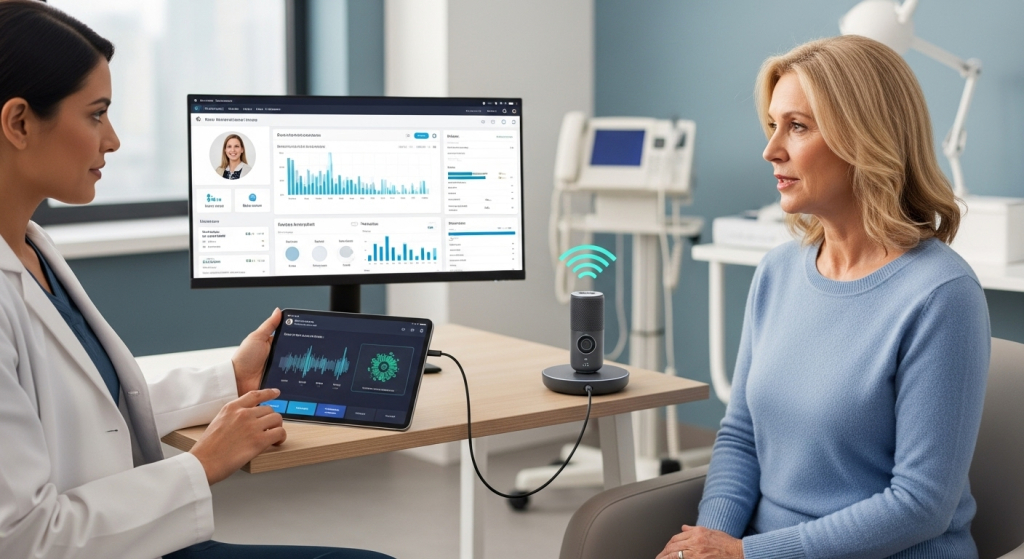The pharmaceutical industry is in a race against time, with the average clinical trial lasting over a decade and costing billions of dollars. Such extensive timelines and monumental costs often delay life-saving treatments from reaching patients who desperately need them. Therefore, the complexities of patient recruitment, research data collection, and trial management have long been bottlenecks in the process, but a new frontier is emerging.

The rise of AI in clinical trials, and specifically, the application of voice AI in clinical research, has the potential for revolutionizing clinical trials and conducting medical studies. That promises to streamline operations and unlock unprecedented efficiencies. This article examines the transformative potential of voice AI, exploring how this technology addresses some of the most persistent challenges in clinical trials and paves the way for a more agile, patient-centric future.
Ready to accelerate your clinical trial? Our team has deep domain expertise in developing compliant, custom AI and voice AI solutions designed to optimize clinical trials!
A Glimpse into the Bottlenecks of Traditional Clinical Trials
Before we can fully appreciate the solution, we must understand the scope of the problem. Traditional trials are mired in inefficiencies that contribute significantly to the high failure rate of new drugs. A staggering 86% of clinical trials fail to meet their enrollment targets, leading to extensions or outright cancellation, with recruitment and retention often cited as the primary reasons for premature termination. Once a patient is enrolled, the data collection process is often manual and fragmented, relying on paper diaries, in-person visits, and cumbersome electronic data capture (EDC) systems.
Table 1. Key Challenges in Traditional Clinical Trials
| Challenge | Description | Estimated Impact with AI |
|---|---|---|
| Patient Recruitment & Retention | Difficulty in enrolling sufficient patients and high dropout rates. | 86% of trials fail enrollment targets; 30% average dropout |
| Subjective & Inaccurate Data | Reliance on patient recall, leading to bias and errors in reported outcomes. | Significant data variability; prolonged data cleaning |
| Operational Inefficiencies | Manual administrative tasks, data entry, and site management burden. | 25-30% of trial budget on administration; staff burnout |
| Limited Real-World Data | Episodic data collection, missing continuous insights into patient’s daily life. | Reduced ecological validity; incomplete efficacy picture |
Patient Recruitment and Retention
Identifying and enrolling eligible trial participants is a major hurdle. Despite rigorous screening protocols and extensive advertising, many trials struggle to find enough qualified patients. Even with successful enrollment, high dropout rates (sometimes, over 30% in long-term studies) can compromise the integrity of the trial and require costly extensions or even outright termination.
Factors such as the burden of frequent site visits, lack of engagement, travel time, parking costs, complex protocol requirements, and poor communication contribute to patient attrition. Besides, geographically centralised trial sites often exclude a large portion of the population, exacerbating recruitment challenges.
Subjective and Inaccurate Data
Patient-reported outcomes (PROs) are crucial for understanding a treatment’s impact on a patient’s quality of life and daily functioning. However, these data points can be highly unreliable when collected through traditional methods. Patients may forget to log their symptoms, inaccurately recall their experiences days or weeks later, or even consciously alter responses due to social desirability bias.
This recall bias and subjectivity make it exceedingly difficult for researchers to draw objective, precise conclusions about a drug’s efficacy and safety. The reliance on paper diaries or cumbersome digital forms further reduces compliance and the granularity of data collected.
Operational Inefficiencies
The logistical burden on clinical trial sites is immense, often leading to significant operational inefficiencies. From scheduling multiple appointments for each patient to managing vast amounts of paperwork, manual data transcription, and quality checks, staff are frequently overwhelmed. This administrative overload contributes to errors, delays in data submission, and a significant amount of “rework” to correct discrepancies.
A study by the Tufts Center for the Study of Drug Development (CSDD) indicated that clinical trial administrative costs could account for up to 25-30% of the total trial budget. That also contributes to staff burnout and high turnover rates at research sites.
Limited Real-World Data
Traditional trials offer only episodic snapshots of a patient’s health, captured during scheduled visits to a clinic. They often fail to capture the nuanced, day-to-day fluctuations in a patient’s condition, their adherence to medication, or their overall well-being in their natural environment. This lack of continuous, real-world data limits our understanding of a drug’s actual impact on a patient’s daily life, making it more challenging to assess its effectiveness outside a controlled clinical setting. The ecological validity of trial findings can be compromised, potentially leading to a disconnect between trial results and actual patient outcomes in the real world.
That is where AI is poised to shine, offering a new path forward.
How Voice AI in Clinical Trials is Reshaping the Industry
Voice AI, a subfield of artificial intelligence for clinical trials, is emerging as a powerful tool to address these long-standing challenges. By leveraging natural language processing (NLP), machine learning, and sophisticated acoustic analysis, voice AI can interact with patients, collect data, and provide insights in a manner previously impossible.

Enhancing Patient Engagement and Data Collection
Voice AI models could serve as virtual clinical assistants, interacting with patients in a conversational and user-friendly manner. Patients can speak their responses to daily symptom diaries, medication reminders, or quality-of-life questionnaires.
- Improved Accuracy and Consistency. Patients are more likely to provide timely and accurate data when the process is as simple as a conversation. That reduces recall bias and improves data quality. Conversational AI can prompt patients for clarification, ensuring that responses are clear and complete. Studies show that AI notes can be over 98% accurate in good acoustic conditions. With advancements in noise reduction and speaker diarization, this accuracy continues to improve in real-world settings.
- Increased Compliance. Automated, personalised voice reminders delivered at optimal times enhance medication adherence and the completion of scheduled tasks, resulting in more robust data sets. These reminders are adaptive, learning a patient’s habits and adjusting delivery times for maximum effectiveness. For instance, AI might learn that a patient responds better to morning reminders for medications, reducing missed doses.
- 24/7 Support and Monitoring. Voice AI assistants are always available, providing a continuous channel for patients to report adverse events, ask common questions, or express concerns. That fosters a sense of constant support and care, particularly valuable for patients in remote locations or those managing complex conditions. The immediate availability of support can also prevent minor issues from escalating into major problems that could lead to trial withdrawal.
That removes the friction associated with manual entry and promotes a more consistent and timely data stream.
Unlocking Objective, Biomarker-Level Insights from Voice
One of the most exciting aspects is the AI’s ability to move beyond subjective clinical trial reports and extract objective, quantifiable data from a patient’s voice. A person’s voice can hold a wealth of information about their physical and mental health. Subtle changes in pitch, rhythm, tone, intensity, and articulation, often imperceptible to the human ear, can be early indicators of a wide range of conditions, effectively acting as “vocal biomarkers.”
A table below lists specific vocal parameters that can be analyzed by AI and the various health conditions they are linked to, showcasing the breadth of vocal biomarker potential.
Table 2. Vocal Biomarkers and Associated Health Conditions
| Vocal Parameter | Description | Associated Health Conditions |
|---|---|---|
| Pitch (F0) | Fundamental frequency of vocal fold vibration | Parkinson’s, Depression, Laryngeal Disorders |
| Jitter | Variability in pitch period | Parkinson’s, ALS, Voice Disorders |
| Shimmer | Variability in amplitude of vocal fold vibration | Parkinson’s, Voice Disorders |
| Speaking Rate | Words per minute, pauses | Depression, Anxiety, Neurological Decline |
| Prosody (intonation) | Rhythm, stress, intonation of speech | Depression, Aphasia, Schizophrenia |
| Formant Frequencies | Resonances of the vocal tract | Respiratory Issues, Laryngeal Masses |
| Tremor | Involuntary oscillations in voice | Essential Tremor, Parkinson’s |
| Cough/Breathing Sounds | Acoustic characteristics of respiratory events | Asthma, COPD, Pneumonia, COVID-19 |
- Neurological Disorders. Voice changes are a well-documented symptom of diseases like Parkinson’s, Alzheimer’s, Huntington’s, and ALS. Artificial intelligence and machine learning in clinical research can analyze these vocal biomarkers to detect disease onset or progression earlier and with greater precision than traditional subjective assessments. For example, AI and machine learning models can identify micro-changes in a patient’s vocal frequency (pitch), amplitude (loudness), jitter (variations in pitch period), shimmer (variations in amplitude), and speaking rate that are characteristic of early-stage Parkinson’s disease, long before overt motor symptoms appear. That allows for earlier intervention and more precise monitoring of treatment efficacy.
- Respiratory Conditions. The acoustic properties of a cough, a strained breath, or changes in speech due to shortness of breath can provide crucial insights into conditions like asthma, COPD, pneumonia, and even infectious diseases like COVID-19. AI can analyze these sounds for patterns indicative of severity or exacerbation, enabling remote monitoring and timely intervention.
- Cardiovascular Health. Research is exploring how subtle voice changes, potentially linked to vocal cord tremors or alterations in vocal tract mechanics due to fluid retention, may be associated with conditions such as congestive heart failure.
- Mental Health. The emotional and tonal qualities of a person’s speech, including prosody, pace, and variability, can be indicative of depression, anxiety, stress levels, and even suicidal ideation. Voice AI provides a powerful, non-intrusive method for monitoring mental well-being in a trial setting, offering objective data that complements traditional psychiatric assessments. That is particularly valuable for neurological or psychiatric medications, where mood changes are critical trial outcomes.
This capability transforms a patient’s voice from a source of anecdotal information into a rich, objective, and continuous data stream, fundamentally changing how we measure treatment efficacy and disease progression.
Streamlining Operational Efficiencies
Beyond patient interactions, voice AI can significantly reduce the administrative and logistical burden on clinical trial staff, freeing them to focus on more complex, patient-facing tasks.
- Automated Scheduling and Reminders. Voice-enabled systems can automate appointment scheduling, send proactive reminders, and confirm attendance through natural language conversations. That reduces the time clinical coordinators spend on phone calls and email exchanges, which frees up substantial staff resources. This automation also leads to a reduction in missed appointments, improving trial adherence and data collection timelines.
- More intelligent Triage and Query Management. Voice AI can serve as the first line of communication for patient inquiries, answering common questions about trial protocols, medications, or side effects. It can efficiently triage more serious concerns or adverse events directly to clinical staff, ensuring that urgent issues are addressed promptly. This intelligent routing prevents staff from being overwhelmed by routine questions, allowing them to prioritize critical patient interactions.
- Real-time Data Integration and Cleaning. Voice-collected data can be automatically processed, transcribed, and integrated into existing Electronic Health Record (EHR) and Electronic Data Capture (EDC) systems. That provides a real-time, comprehensive view of a trial’s progress and patient health. This seamless integration eliminates the need for manual data entry, which is a primary source of errors and delays in traditional trials. Furthermore, AI algorithms can perform initial data validation and flag potential inconsistencies for human review, significantly reducing the data cleaning phase — a notoriously time-consuming part of any clinical trial.
This operational efficiency is a key reason why AI in clinical trials is gaining traction, promising to shorten timelines, reduce costs, and enhance the overall quality of clinical research processes.
A table illustrates the percentage reduction in various operational costs (e.g., administrative staff time, data entry errors, recruitment costs) achieved through the implementation of voice AI.
| Operational Area | Estimated Cost Reduction with Voice AI |
|---|---|
| Administrative Staff Time | 30-40% |
| Data Entry Errors | 70-80% |
| Patient Recruitment Costs | 15-25% |
| Data Cleaning & Validation | 50-60% |
| Site Visit Logistics | 20-30% |
Deep Dive into Implementation: From Concept to Clinical Practice
The journey from a voice AI concept to a viable, deployable tool in a clinical trial is complex. It involves critical stages, each requiring a specialized approach powered by AI for clinical trials.

Data Acquisition and Model Training
The foundation of any booming voice AI application is a massive and diverse dataset. To train a model that can accurately detect vocal biomarkers for a specific disease, researchers need an extensive collection of voice recordings from both healthy individuals and patients at various stages of the condition. This data must be meticulously labelled and annotated, indicating the presence and severity of symptoms, which is often a semi-automated process powered by machine learning models themselves.
The quality, volume, and diversity of this training data are paramount to preventing algorithmic bias, ensuring the model performs well across different demographics, ages, genders, accents, and vocal characteristics. For example, training data must include diverse linguistic backgrounds to prevent a model from performing poorly on non-native speakers.
Secure Infrastructure and Data Handling
Given the highly sensitive nature of health information, a secure and compliant infrastructure is non-negotiable. Voice data is captured using secure, validated devices or applications, encrypted at the source, and transmitted to a secure cloud environment. Here, the data is typically de-identified or anonymized before processing to extract vocal biomarkers, with the raw audio files often being immediately deleted or stored in a separate, highly protected archive accessible only under strict protocols.
The entire system must be designed and operated to be fully HIPAA compliant in the U.S. and GDPR compliant in Europe, along with other relevant local data protection regulations, ensuring patient privacy is protected at every step from data capture to analysis and storage. Regular security audits and penetration testing are essential.
User Interface and Patient Experience
For a voice AI assistant to be truly effective, it must be easy and intuitive for patients to use. It means designing a user experience that is conversational, empathetic, and accessible. The AI should understand natural language with a high degree of accuracy, handle a wide range of accents and dialects, and respond in a way that feels helpful, reassuring, and non-judgmental. The goal is to make the interaction feel less like a clinical task and more like a casual, supportive conversation, which encourages consistent engagement and honest reporting.
For a patient with a chronic illness or limited mobility, a quick, voice-based check-in from their home is far less burdensome than filling out a lengthy paper form or travelling to a clinic. That reduced friction directly translates to better adherence, higher retention, and superior data quality. User feedback loops are critical during development to refine the conversational flow.
Integration with Existing Systems
A standalone voice AI tool has limited value within a complex clinical trial ecosystem. Its true power is unlocked when it seamlessly integrates with existing clinical trial management platforms, EDC systems, and EHRs. That is a critical technical challenge that requires robust Application Programming Interfaces (APIs) and a deep understanding of the intricate data flows and standards within the clinical research ecosystem (e.g., CDISC standards).
The voice AI platform must be able to push processed data (e.g., symptom scores, vocal biomarker readings, medication adherence logs) directly into the trial’s central database in real-time. That eliminates the need for manual data entry by site staff, reducing the administrative burden, minimizing data transcription errors, and providing researchers with immediate access to crucial data. The result is a more efficient, less costly, and ultimately more accurate trial.
ROI: Quantifying the Value of AI in Clinical Trials
The implementation of advanced technologies, such as generative AI, is about achieving a tangible return on investment (ROI) that can reshape the economics of drug development.
The table shows estimated average cost savings (in millions of USD) per clinical trial phase when voice AI is effectively implemented, providing high ROI across the development pipeline.
| Trial Phase | Average Cost Savings (Millions USD) |
|---|---|
| Phase I | $1 – $3 |
| Phase II | $5 – $15 |
| Phase III | $20 – $50+ |
| Total | $26 – $68+ |
- Reduced Trial Timelines. By accelerating patient recruitment through broader reach and continuous engagement, and by enabling more frequent and timely data collection, voice AI can significantly shorten the overall duration of a clinical trial. Each day saved in a Phase III trial, for example, can translate to millions of dollars in reduced operational costs and, more importantly, an earlier market entry for a new drug. This earlier market access can generate billions of dollars in additional revenue due to an extended patent life and a first-mover advantage.
- Lowered Operational Costs. The automation of routine, labour-intensive tasks (like data entry, scheduling patient appointments, sending reminders, and initial data validation) reduces the need for extensive site staff resources. This operational efficiency results in a direct reduction of overhead costs, allowing highly trained clinical staff to focus on higher-value activities, such as complex patient care, protocol adherence, and intricate data analysis. AI also reduces the cost of printing, distributing, and managing paper diaries and forms.
- Improved Data Quality and Integrity. High-quality, real-time data collected directly from patients in their natural environment reduces the risk of trial failure due to insufficient, unreliable, or incomplete data. That is a major financial factor, as the cost of a failed Phase III trial can easily exceed $100 million. By providing richer, more accurate, and more frequent data points, voice AI aids in mitigating the risks associated with the entire development process, leading to more robust results and increasing the likelihood of regulatory approval. Reduced data queries and faster data cleaning also contribute to cost savings.
- Enhanced Patient-Centricity and Retention. From a business perspective, a better, more convenient patient experience directly translates to higher retention rates. A trial that is easy and convenient for patients to participate in, reducing the burden of clinic visits and manual logging, will naturally have a lower dropout rate. That saves significant time and cost associated with recruiting and onboarding new participants to compensate for attrition, which can be a continuous and expensive process in traditional trials. High patient satisfaction also enhances the reputation of the sponsor and trial site.
The financial and operational benefits of integrating AI in clinical trials are substantial and directly impact the bottom line for pharmaceutical companies and Contract Research Organizations (CROs).
Ethical and Regulatory Considerations
While the potential of AI in clinical trials is immense, its implementation is not without its challenges, particularly in terms of AI ethics and regulatory oversight. The use of highly sensitive health data requires meticulous consideration to ensure patient privacy, data security, and the fair and equitable application of these powerful technologies.
- Data Privacy and Security. The collection of voice data, which can contain highly personal information, raises significant concerns regarding privacy. Companies must adhere to strict data protection regulations like HIPAA in the U.S., GDPR in Europe, and other regional laws. Solutions include robust end-to-end encryption for data in transit and at rest, stringent access controls, pseudonymization or anonymization techniques before data processing, and potentially federated learning.
Federated learning enables AI platforms to be trained on local data on a device or at a specific institution, eliminating the need to centralize or directly transfer raw, sensitive data, thereby enhancing privacy. Regular, independent security audits and penetration testing are crucial for identifying and mitigating vulnerabilities.
- Bias and Fairness. AI models are only as good as the data they are trained on. If the training data is not diverse and representative of the patient population — lacking sufficient samples from different ethnic groups, age ranges, genders, socioeconomic backgrounds, or linguistic varieties — the models may inherit and amplify existing biases. That could lead to inaccurate or less effective results for underrepresented populations, potentially exacerbating health disparities.
For example, a voice AI trained predominantly on a specific accent might perform poorly for individuals with different accents. Addressing bias requires diverse datasets, robust validation across different demographic groups, and proactive strategies for detecting and mitigating bias throughout the AI development lifecycle.
The table below illustrates how increasing the diversity of training data (e.g., incorporating more varied accents and demographics) correlates with improved overall AI model accuracy and reduced performance disparities across different user groups.
| Data Diversity Level | AI Accuracy (Homogenous Group) | AI Accuracy (Diverse Group) |
|---|---|---|
| Low (Homogenous Data) | 98% | 65% |
| Medium | 95% | 80% |
| High (Diverse Data) | 96% | 94% |
- Transparency and Explainability. Many advanced AI tools, intense learning networks, operate as “black boxes,” making it difficult for humans to understand how they arrive at a particular conclusion. This lack of transparency can undermine trust among patients, clinicians, and regulatory bodies. In clinical trials, understanding why an AI identified a specific vocal biomarker or suggested a particular course of action is crucial for safety and accountability.
The development of Explainable AI (XAI) is crucial, as it provides clear insights into an AI’s decision-making process, the features it prioritizes, and its confidence levels. That helps clinicians validate AI outputs and ensures that the AI is used as a decision-support tool, not a black-box oracle.
- Regulatory Compliance and Validation. Regulatory bodies, such as the FDA in the U.S. and the European Medicines Agency (EMA), as well as other national health authorities, are actively developing frameworks for the approval and oversight of AI-driven medical devices and software, including those used in clinical trials. That involves establishing guidelines for data quality, model validation, clinical utility, and ongoing performance monitoring.
The FDA’s Predetermined Change Control Plan (PCCP) guidance, for example, is an innovative approach that allows for specified, pre-approved modifications to AI-enabled devices (like updates to the AI algorithm) without requiring a new marketing application for each minor change, streamlining the innovation process while ensuring patient safety and device effectiveness. Clear guidelines for what constitutes a “significant change” that requires re-approval are continually being refined. The validation process for vocal biomarkers must be as rigorous as for any other biomarker, demonstrating sensitivity, specificity, and reproducibility.
The integration of AI in clinical trials must therefore be a collaborative and continuous effort involving technology developers, clinical researchers, ethicists, and regulatory bodies. That ensures that these powerful tools are developed and deployed responsibly, ethically, and in a manner that truly serves the best interests of patients and public health.
Conclusion: The Future is Conversational
The journey through the complexities and triumphs of AI in clinical trials reveals a clear and compelling vision for the future of medical research. The current challenges of traditional trials, including patient recruitment and retention, data quality, and operational burden, are no longer the primary roadblocks. Voice AI offers a robust, elegant, and human solution to these issues.
By transforming a patient’s voice into a rich source of objective information and providing a conversational, low-friction interface, this tech is reinventing it from the ground up. We transition from a model of episodic, subjective data collection to one of continuous, real-world monitoring. That promises to accelerate breakthroughs and bring life-saving therapies more quickly.
However, as we embrace this new era, we must do so with caution and foresight. The ethical responsibility to protect patient data, ensure algorithmic fairness, and maintain transparency in AI’s decision-making process is paramount. The ultimate success of artificial intelligence in clinical trial design will depend on our collective ability to build robust, secure, and equitable systems that earn the unwavering trust of patients, clinicians, and regulatory bodies alike.
Looking ahead, the synergy between digital health and voice AI technologies will undoubtedly create a new paradigm for decentralized clinical trials. Imagine a world where a patient’s entire health journey, from subtle vocal biomarkers indicating disease progression to continuous heart rate monitoring and activity levels, is passively and seamlessly captured and analyzed. This multimodal, real-time data stream will provide researchers with a deeper insight, enabling more precise and personalized medicine, as well as personalized, highly adaptive trial designs where interventions are tailored based on an individual’s unique physiological and vocal responses.
Move beyond subjective patient-reported outcomes. Our voice AI solutions analyze vocal biomarkers to provide objective, real-time insights into disease progression!
FAQ
How can my clinical trial benefit from voice AI beyond just transcribing patient notes?
Voice AI is far more than a transcription tool. It transforms a patient’s voice into a rich source of objective data, or “vocal biomarkers,” that can reveal subtle health changes imperceptible to human ears. Thus, voice AI enables continuous, real-time monitoring of neurological disorders, mental health conditions, and respiratory conditions. By providing this deeper level of insight, voice AI gives researchers a more accurate and comprehensive picture of a treatment’s impact, reducing reliance on subjective patient recall and enhancing data integrity.
Is using voice AI for clinical data secure and compliant with regulations like HIPAA and GDPR?
Absolutely. Data security is paramount. Voice AI solutions are built with strict security protocols to ensure compliance with global regulations. That includes end-to-end encryption of all voice data, de-identification of personal information before analysis, and robust access controls. Many systems utilize a secure, compliant cloud infrastructure, and some even employ federated learning, which enables AI systems to be trained on data locally without transferring sensitive, raw audio files, maximizing patient privacy.
Will AI replace human researchers and site staff in clinical trials?
No, AI is designed to be a powerful assistant, not a replacement. It automates repetitive administrative tasks, such as scheduling reminders, data entry, and initial patient queries. That frees up valuable time for clinical staff to focus on critical, human-centric activities, such as providing direct patient care, conducting complex analyses, and building relationships. The most effective approach is a “human-in-the-loop” model, where AI provides data-driven insights that empower researchers to make more informed and efficient decisions.
How does voice AI address the central problem of patient recruitment and retention?
Voice AI enhances patient engagement by making trial participation more convenient and less burdensome. Patients can report symptoms and ask questions from the comfort of their homes, reducing the need for frequent, costly in-person visits. This conversational, low-friction interface increases patient compliance with study protocols and improves overall satisfaction. Higher engagement and reduced burden directly lead to lower dropout rates, which improve the integrity and success of the clinical trial.
Can voice AI help a trial identify hidden insights from patient data?
Yes. Voice AI excels at uncovering subtle patterns that are often missed by traditional methods. It can analyze the nuances of a patient’s speech — such as pitch, pace, and vocal tremor — to identify early indicators of disease progression or treatment response. That allows researchers to gather objective data on conditions where subjective reporting is unreliable, leading to a deeper and more accurate understanding of a drug’s efficacy and enabling more precise, data-driven conclusions.
What makes voice AI data more reliable than patient-reported paper diaries?
Paper diaries are prone to recall bias, as patients often fill them out at the end of the day or week, relying on memory. They can also be lost, damaged, or contain illegible handwriting. Voice AI, by contrast, facilitates real-time data capture. A patient can immediately report a symptom or side effect as it occurs, leading to more accurate and granular data. This timeliness eliminates recall bias and provides a continuous, high-fidelity data stream for researchers.



